If you’re a Brood I cicada, you’re probably instar 4.
10 years ago meme (which is a thing in January of 2022):
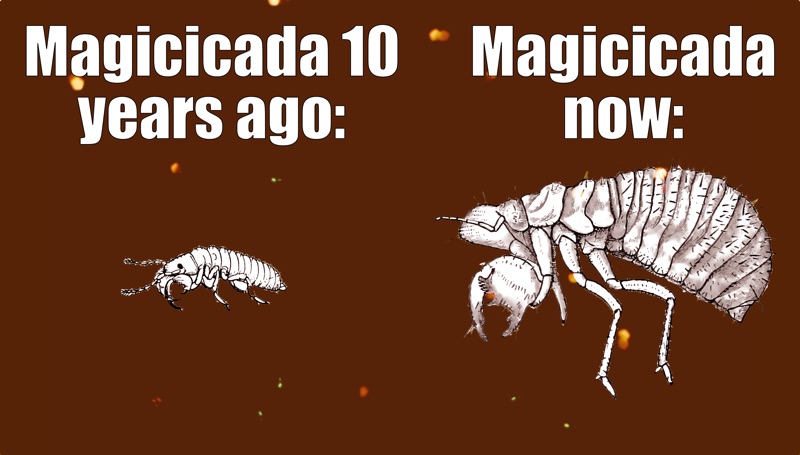
If you’re a Brood I cicada, you’re probably instar 4.
10 years ago meme (which is a thing in January of 2022):

Steve send us this video of his daughter Elena’s Cicada Song. I hope you enjoy it:
No matter what you celebrate — Christmas, Hanukkah, birthdays, graduations, Treat Yourself Day — cicada-related items are a great gift! At the end of 2021, I’m sharing cicada gift-related ideas, here and on social media. Check back for more tips.
The Season of Cicadas is the best general book about North American cicadas in print.
This is the best book about cicadas found in Australia in print. Get it from this website.
This is the only book about the cicadas of New Zealand that I know of. Get it from this website.
Many will remember the Brood X cicada emergence. How about a souvenir of the emergence and a useful notebook? Check out headbone’s Brood X notebook.
Sue Fink’s “Cicada Suite” features 2 songs about cicadas on an adorable cicada-shaped flash drive. Irresistible!
Cecily Cicada is a fictional story for kids about a cicada named Cecily. It is a perennial favorite.
Each day I’ll add more gift ideas here.
This is a list of cicada-related research published in 2021.
More than 60 so far (12/24/2021). Email cicadamania@gmail.com with any more.
It isn’t often we get a single cicada publication as complete and awesome as Cicadas of southern Africa: An illustrated guide to known species by R.D. Stephen. The document is 224 pages long and includes color photos of dozens of cicadas with maps & text descriptions. This guide covers cicadas from Botswana, Lesotho, Namibia, South Africa, and Zimbabwe.
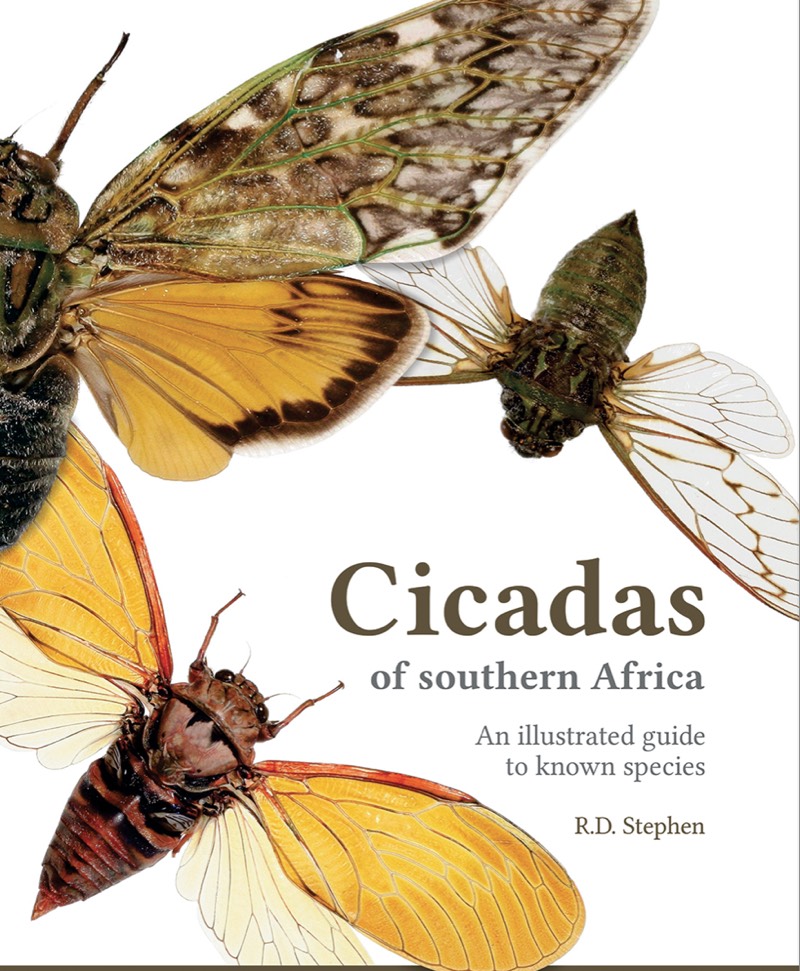
Thanks to beetledude in iNaturalist and David Emery for letting me know.
The paper The molecular systematics and diversification of a taxonomically unstable group of Asian cicada tribes related to Cicadini Latreille, 1802 (Hemiptera:Cicadidae)1 has introduced a new tribe Ayuthiini, replacing Tosenini for two genera of cicadas: Distantalna and Ayuthia.
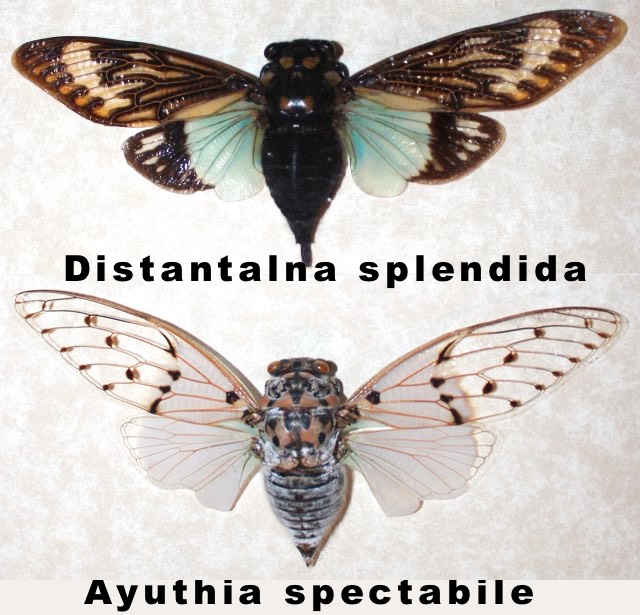
1 Hill Kathy B. R., Marshall David C., Marathe Kiran, Moulds Maxwell S., Lee Young June, Pham Thai-Hong, Mohagan Alma B., Sarkar Vivek, Price Benjamin W., Duffels J. P., Schouten Marieke A., de Boer Arnold J., Kunte Krushnamegh, Simon Chris (2021) The molecular systematics and diversification of a taxonomically unstable group of Asian cicada tribes related to Cicadini Latreille, 1802 (Hemiptera:Cicadidae). Invertebrate Systematics 35, 570-601. https://doi.org/10.1071/IS20079
A few years back a project was launched to discover if the New Forest cicada (Cicadetta montana) still exists in England. It once existed in southern England for sure, but seems to have gone extinct. To date, none have been found.
Recently a cicada was reported found in England on iNaturalist, appearing to belong to the genus Tibicina. The best resource for European cicadas is SONGS OF EUROPEAN SINGING CICADAS. Looking at the navigation of the website it looks like there are nine Tibicina in Europe (maybe more). The cicada on iNaturalist is brown with orange highlights: u-shaped marks on its mesonotum, an orange outline of its pronotal collar, and an orange line down the middle of its head. Wing veins appear brown & black and appear to be warped during the molting process. It might be teneral — still soft from the molting process — and so its adult colors have not fully developed.
So — is it a native to England or a stowaway in some cargo from mainland Europe?
The Twitter account @MorphoCicada posted this on Twitter, which alerted me to the matter.
Hieroglyphic cicadas (Neocicada hieroglyphica aka Hieroglyphic Cicada) are present in most of southern New Jersey, particularly the Pine Barrens area which has sandy soil (pure sand in a lot of places) and many pine and oak trees. This area is historically prone to fires because of the dry sandy soil and sappy pines. The fact that at least some Hieroglyphic cicadas appear every year and spend many years underground probably helps them circumvent minor fires.
Here’s a photo of a Hieroglyphic and Northern Dusk-Singing Cicada exuvia (shed skin). Quite a difference! Brendan T. Byrne State Forest.
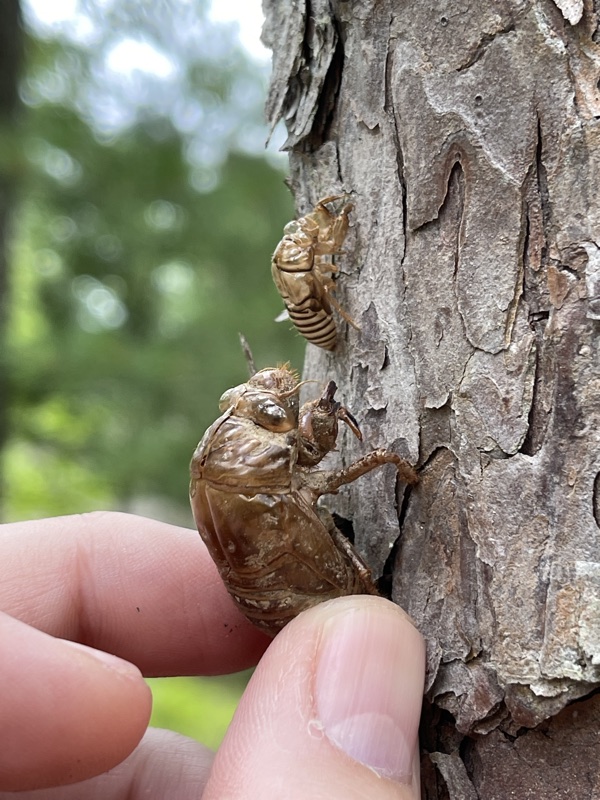
Some Locations:
All these areas are heavily infested with ticks, deer flies, and in some cases, mosquitos. Take precaution.
Recently a new paper was published with the authors Kathy B. R. Hill, David C. Marshall, Kiran Marathe, Maxwell S. Moulds, Young June Lee, Thai-Hong Pham, Alma B. Mohagan, Vivek Sarkar, Benjamin W. Price, J. P. Duffels, Marieke A. Schouten, Arnold J. de Boer, Krushnamegh Kunte and Chris Simon titled The molecular systematics and diversification of a taxonomically unstable group of Asian cicada tribes related to Cicadini Latreille, 1802 (Hemiptera: Cicadidae) in Invertebrate Systematics, 2021, 35, 570—601. Link to the paper.
Here’s the abstract:
Abstract. The cicadas (Hemiptera: Cicadidae) related to tribe Cicadini exhibit some of the most remarkable phenotypes in the family, with many genera possessing striking colour patterns and unusual morphological features. This largely Asian group of 13 tribes has proven challenging for cicada taxonomists, in part because of likely convergent evolution or losses of these phenotypes. We present the first focused molecular phylogeny of this clade, including ~60 described genera. The genetic dataset contains 839 ingroup-informative sites (out of 2575) from mitochondrial cytochrome c oxidase subunit I, nuclear elongation factor-1 a, and nuclear acetyltransferase. We use Bayesian and maximum likelihood trees to test recent changes in tribe- and subtribe-level classification, and we reconstruct ancestral character states for potentially convergent traits influencing tribe descriptions. We use fossil and molecular clock calibrations to estimate the temporal and geographic context of the radiation. The tribes Gaeanini, Leptopsaltriini, Platypleurini, Psithyristriini, and Tosenini appear polyphyletic and in need of revision, in part because of convergent evolution of opaque wings and multiple convergent gains or losses of abdominal tubercles. Kalabita Moulton, 1923 is transferred from Platypleurini to Leptopsaltriini. Vittagaeana gen. nov. is established for Vittagaeana paviei comb. nov. and Vittagaeana dives comb. nov., formerly in Tosena. Sinosenini syn. nov. is synonymised with
As part of the paper, we get a new genus, Vittagaeana, made up of two cicadas formerly belonging to the genus Tosena. They were likely placed under Tosena because of the white line on their forewings, but after a review of genetics and other features, they have been given their own genus. They are closely related to the genera Ambragaeana, Callogaeana, Gaeana, Sulphogaeana and Trengganua. Also similar to Balinta, Paratalainga, and Talainga.
Vittagaeana dives (Westwood, 1842), formerly Tosena dives:
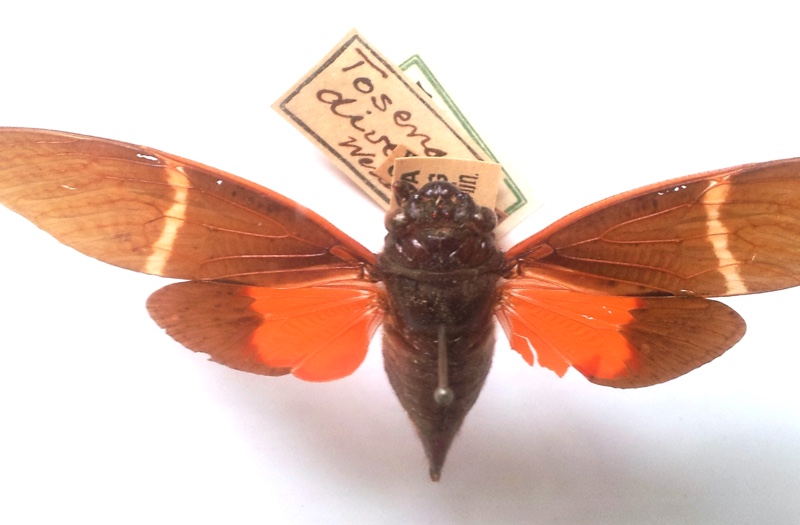
More info: Vittagaeana dives (Westwood, 1842)
Vittagaeana paviei (Noualhier, 1896), formerly Tosena paviei:
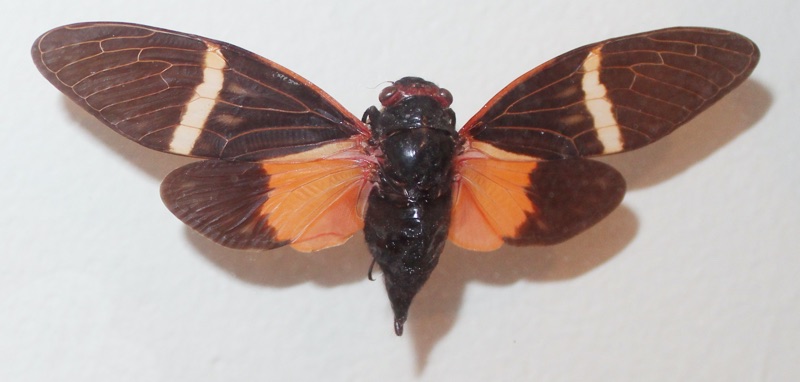
More info: Vittagaeana paviei (Noualhier, 1896)
Brood X Magicicada photos by Jim Occi taken in Princeton, set 6. 2021.
Teneral Magicicada:
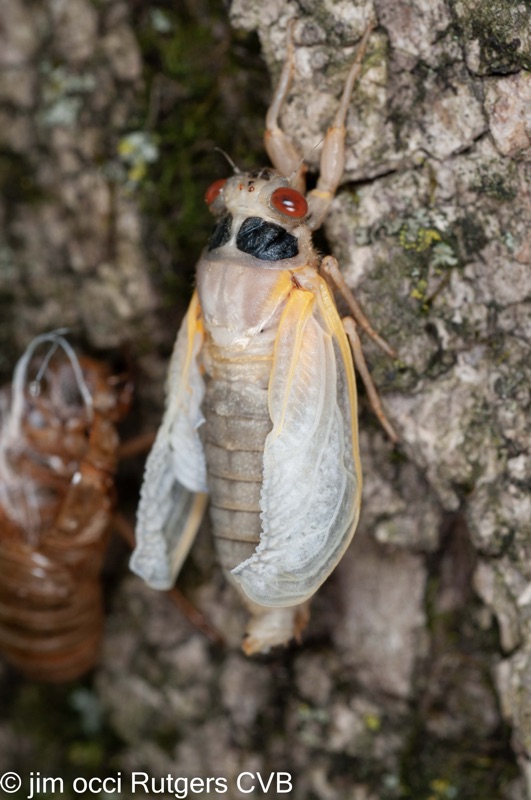
Teneral Magicicada:
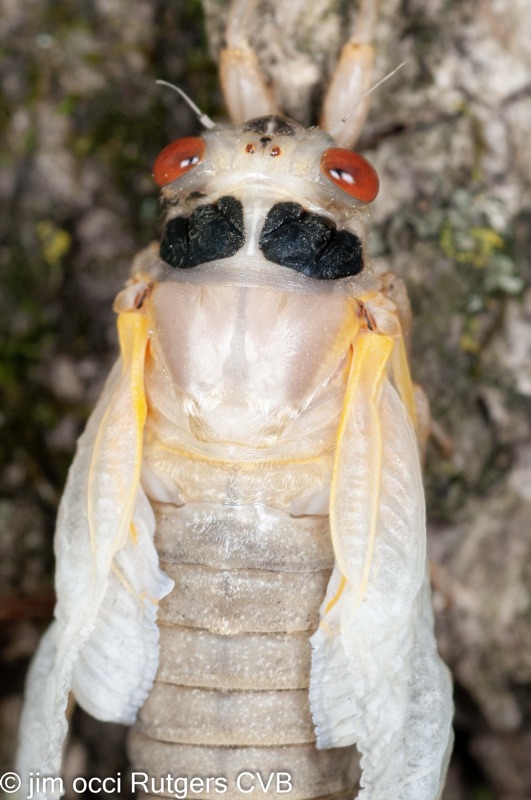
Magicicada septendecim that failed to completely exit its exuvia before its body hardened:
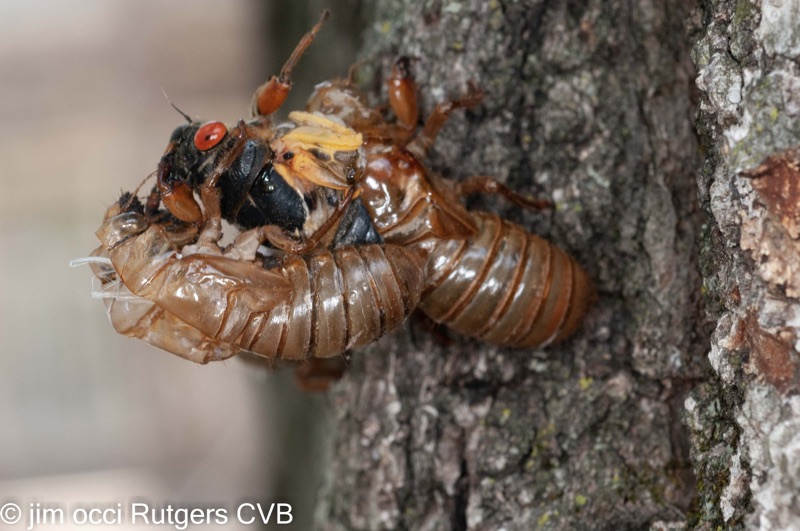
Magicicada septendecim that failed to completely exit its exuvia before its body hardened:
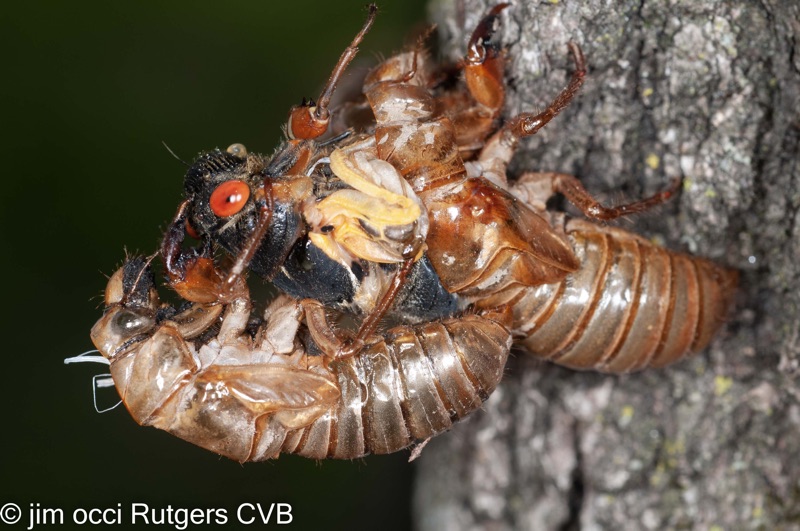
A pair of Magicicada septendecim:
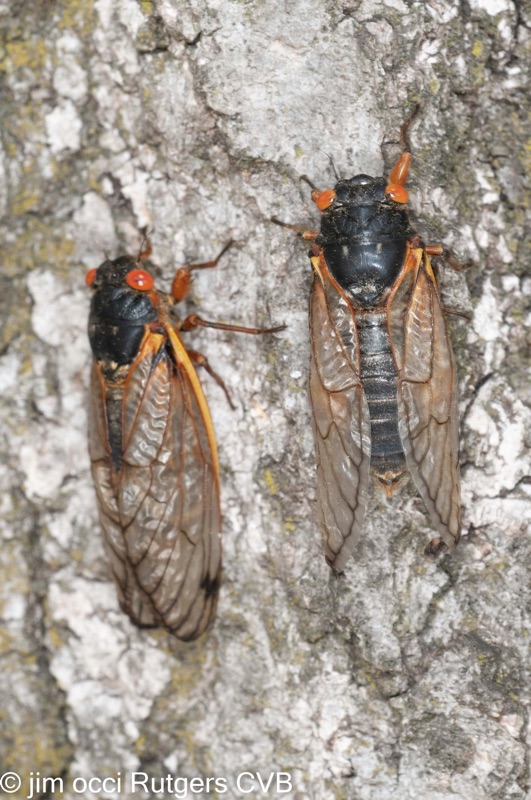
More from Jim Occi: